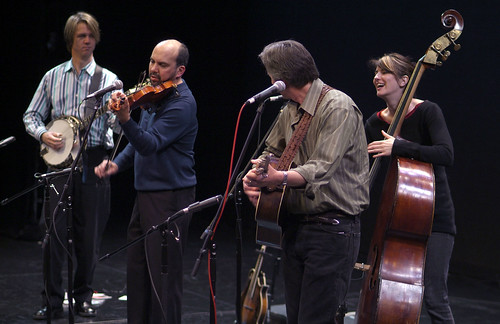Lincoln Center Institute for the Arts in Education presents "Mountain Music" on Friday, May 7th at 1 pm in the Roosevelt Island School (P.S./I.S. 217) auditorium for grades Pre-K through Grade 2 and Class 345. Families are welcome to attend, but will need to sit in the back of the auditorium to accommodate seating for the students.
Our Pre-K through Grade 2 students and Class 345 have begun their residency with Lincoln Center. "Mountain Music" program allows the students to explore "Bluegrass" - a uniquely American style of music which sprang from the mountains of the middle Atlantic states. Originally combining melodies dating to settlers from the British Isles with the rhythmic and instrumental influences of Africans, Bluegrass clings to its traditional roots while always taking in new influences. Using banjo, fiddle, bass, guitar, mandolin, and vocals, Bob Green and Company bring the children back to the heartland with music old and new, from breakneck instrumental to stirring ballad.
Mountain Music—Notes on the Program
Fire on the Mountain
The typical bluegrass set starts with the band taking the stage in a big hurry. The fiddler launches into a fast mountain breakdown, usually played for only part of its length, as an appetizer to the program which follows.
I Wonder Where You Are Tonight
The first song follows immediately, usually of medium tempo, to contrast with the preceding breakneck romp. This classic comes from deep within the common repertoire, its actual roots long forgotten.
Where the Soul of Man Never Dies
While gospel music is an important element in nearly every American form, it looms particularly large in bluegrass, where the modes of harmony singing are tightly linked with those used in church. I like this song because it is highly secular, yet suggests an afterlife that’s worth waiting for.
El Cumbanchero
A fiery instrumental feature by Virginia mandolinist Jesse McReynolds. He was responsible for much post-Monroe instrumental innovation in the sixties, and invented several techniques that are now part of the instrument’s lingua franca. The song comes originally from the early Puerto Rican bandleader Rafael Hernandez and was recast by Jesse and Co. in their local Virginia lingo.
The Dream of the Miner’s Child
This heartbreaking vocalist’s showcase reminds us of the fears that haunt miners and their families. “Originated in England as a late Victorian parlor ballad, the text was published in the United Mine Workers Journal in 1911. The entire piece was copyrighted by Blind Andy Jenkins, the singing newspaper vendor from Atlanta, Georgia, in 1926, and finally Vernon Dalhart crooned the newly copyrighted version into thousands of homes (including Doc Watson’s) on a Victor record.”—Ralph Rinzler. Blind singer/guitarist Doc Watson has gone on to influence two generations (and counting) of traditional american stylists.
Dixie Breakdown
In most bluegrass bands, the banjo player is featured early and often, and s/he is as likely as not to suggest an Earl Scruggs tune when asked to “pick one.” The tune is passed around so everyone gets to have at least one go at a solo.
I’ll Never Love Anybody but You
This uptempo song with a simple message is the vehicle for a bright vocal trio with instrumental response. Originally from Jim & Jesse and the Virginia Boys.
Saturday, May 1, 2010
Mountain Music - Lincoln Center Program at the Roosevelt Island School (P.S./I.S. 217)
Labels:
concerts,
PS 217 events
Subscribe to:
Post Comments (Atom)
Disclaimer
All data and information provided on this site is for informational purposes only. The opinions expressed by Parent Bloggers do not reflect those of the P.S./I.S. 217 or any employee thereof. The Roosevelt Island School is not responsible for the accuracy of any of the information supplied here. Parent Bloggers may keep updating old posts on a regular basis and are not bound to explicitly state all corrections made.




No comments:
Post a Comment